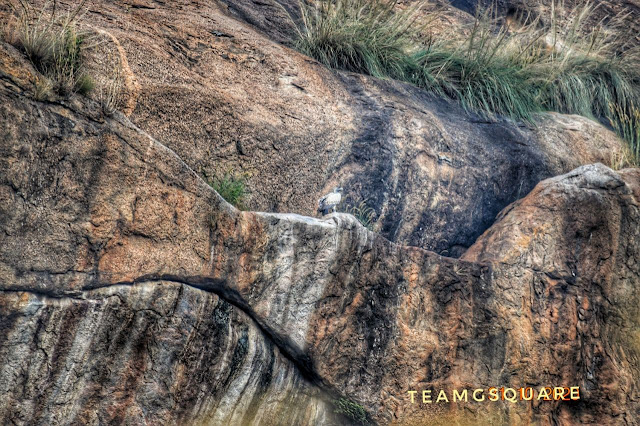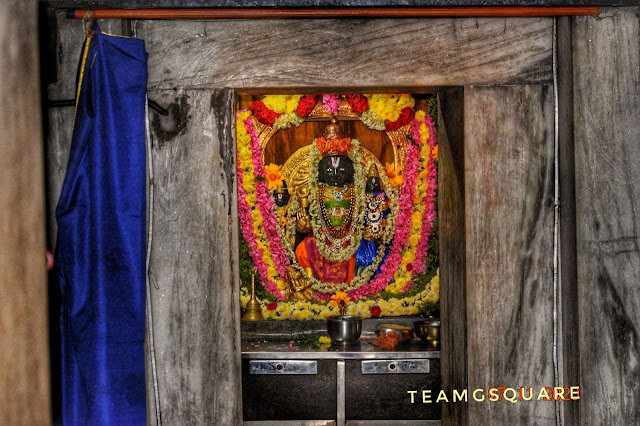Having visited here a few years back, we wished to re-visit this time around with our two young travel partners Adhi and Diya, hoping it would not be too crowded owing to the current COVID situation. But surprisingly, this place was crowded as usual portraying one of the normal days. We were now in two minds whether to continue as per our plan or change the location since the parking itself seemed over crowded. As the kids were all excited to explore this place after seeing the pictures of vulture on the sign boards along the way, they wished to spot one and hence we moved ahead as per plan! They were all the more excited thinking they would get to spot 'Jatayu and Sampati', the vulture siblings born to Lord Garuda (King of Birds) and his consort Unnati.
 |
Egyptian Vulture Couple
|
'Ramanagara' is one of the few vulture sanctuaries across India and Asia. We are fortunate enough to have visited the other two vulture sanctuaries across India - Orchha (Madhya Pradesh) and Anjaneri (Maharashtra). Out of the 9 species of vultures found in India, Ramanagara district is home to 3 of them, namely the Long billed vulture, the Egyptian vulture and the White backed Vulture. Although we have spotted Egyptian vultures during our journeys across Ramanagara district over the last few years, we always wished we could spot one on the Ramadevara Betta. This time, we were in for a surprise! We spotted a Long billed Vulture and this made our kids very happy.
 |
Egyptian Vulture Parched on a Hill, Ramanagar
|
 |
Long Billed Vulture
|
Ramadevara Betta with its many neighboring hills is closely related to Lord Rama. There are many stories of Lord Rama associated with Ramadevara Betta, as the name itself suggests. Lord Rama during his 14 years of exile is believed to have stayed and spent some time here. In all likelihood, Lord Rama would have stayed here while proceeding to Lanka to kill Asuraraja Ravana and free Sita Matha. Although most of the stories narrated by the priests here suggest otherwise, that Lord Rama stayed here accompanied by Sita Matha and Lord Lakshmana. This is debatable since the widely accepted place of Sita-haran (kidnapping) is Panchavati which is located in Nashik on the banks of the river Godavari and Hanuman-milan (Rama meeting Hanuman) is Kishkinda, the environs of Hampi and the capital of Vanara Raja Sugriva, both of them situated towards the north of Ramanagara. Lord Rama's journey during his exile was mostly southward and having spent most of the time during exile in "Dandakaranya", which is believed to be somewhere around Chitrakoot in Chhattisgarh (Central India), it is unlikely that Lord Rama visited this place along with Sita Matha.
 |
Lord Rama's Journey During Exile
|
Undoubtedly, there is enough proof to believe that Lord Rama stayed in Ramadevara Betta. However, the time of his stay could be post Hanuman-milan, during the Lord's journey towards Lanka with Vanara Sainya (army of vanaras). One of the most interesting stories associated with this place is Lord Rama's killing of Kakasura (the crow demon, who is also the son of Lord Indra) with an arrow made of a blade of grass (dharbhe hullu), when it was troubling Sita Matha. Finally, Kakasura seeked refuge and pleaded for forgiveness from Lord Rama when the other gods declined any help. As Lord Rama relieved him from being a crow which was the demon's cursed form, it is said that no crows have ever been sighted in and around this place. This story finds its mention in the Ramayana, when Lord Hanuman meets Sita Matha for the first time in Ashoka Vatika of Lanka. It is when Lord Hanuman requests Sita Matha for giving a proof of meeting her so he can show the same to Lord Rama, that Sita Matha narrates this story to him which only Lord Rama was aware of. Along with the narration of this story, she also handed him her bridal jewellery Chudamani as proof. The episode of Kakasura is believed to have taken place somewhere around Dandakaranya (near Chitrakoot ) on a river bank. Therefore, the occurrence of this incident in Ramadevara Betta is clearly debatable.
 |
Bird's Eye View of Dhanushkodi and Sri Rameshwara Temple
|
 |
Vanara Raja Sugriva's Carving on one of Rock
|
The other story linked with this place is about the Vanara Raja Sugriva after the coronation of Lord Rama. King Sugriva wished to possess a murti of Lord Rama in the form of a king so he could worship the Lord back home at Kishkinda. He therefore got a murti of Lord Pattabhirama carved and got it blessed by the Lord himself. While returning on his way back to Kishkinda, he heard an 'Akashavani' (a voice from the sky), asking him to stop there and kill the demon Handigundi or Sukhasura, who was troubling the maharishis in meditation (tapas) at Ramadevarabetta. Therefore, King Sugriva placed the murti there, fought the demon Sukhasura fiercely and killed him. The demon after his death is believed to have turned into a hill, which is locally known as Handigundi. Handigundi is located about 4 km from the Ramadevara Betta. A few years back we had the opportunity of trekking this hill too. Post the killing of Sukhasura, Sugriva came back to the place where he had kept the murti of Lord Rama but was unable to move it. While doing so, he heard another Akashavani which ordered him to leave the murti there since the Lord wished to remain there only. Thus Sugriva installed the murti and returned to Kishkinda. An interesting fact related to this story is the rare finding of the carving of Lord Sugriva on this hill. Later, Sri Kempegowda renovated this temple sometime during the 16th century and much of the current structure of the temple is attributed to him. In the 1990's, the temple underwent another renovation. The murti of Lord Pattabhirama here is very divine, where the Lord is seen seated on his throne with Sita Matha on his lap accompanied by his brother Lord Lakshmana and his ardent devotee Lord Anjaneya.
 |
Sri Pattabhirama Swamy Temple
|
 |
Lord Pattabhirama Murti
|
Lord Rama during his visit to this place installed a Linga known as Sri Rameshwara to offer daily worship to Lord Shiva. This temple too was renovated during Sri Kempegowda's rule in the sixteen century. The Rama tirtha/ Dhanushkodi / Nydile tirtha is a beautiful ದೊಣೆ (spring water pond) between the two temples. This tirtha/ doNe/ honda is believed to be the creation of Lord Rama when he shot an arrow there in order to get drinking water. The depth of this tirtha however is not known. An elderly person we met here shared many interesting stories about this tirtha (will be shared in a separate post). In 2014, when we visited here in April, this tirtha was full with clear water. The water from this tirtha is used for the Lord's abhishekam (bathing of the deity) and in the preparation of Naivaidya (offering of food to god). The water is also believed to have many medicinal properties having the powers to heal many incurable diseases.
 |
Sri Rameshwara Temple
|
 |
Nydile Tirtha
|
Wherever there is a kote/fort, there is our Lord Anjaneya! There are 5 murtis of Lord Anjaneya in total on the Ramadevara Betta. However, none of them here is seen carved with either his 'gada' (mace) or him carrying 'Dronagiri' parvatha (hill). All the carvings depict the Lord in 'Abhaya Hastha' (blessing hand) posture. As per the archakaru, this posture also means the Lord declaring that he is here to protect his devotees. The carvings are believed to be a swayambhu or self manifested. Except for the one at the entrance of the Ramadevara hill, the rest of the murtis are depicted with sowgandhika puspha (flower) in one hand, similar to the ones across this region especially in places associated with the Kempegowda and family. We happened to visit 4 of the 5 murtis here during our visit.
 |
Kote Anjaneya Swamy
|
To be continued....











One of the beautiful places I have seen
ReplyDeleteSuperb capture and great narrative!!
ReplyDeleteThanks for sharing the details
ReplyDeleteVery nice to know about this temple and beautiful place